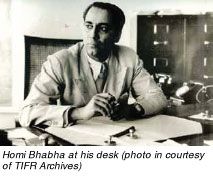Bhabha: The Man and the Physicist

Knowledge once given cannot be taken back- Bhabha
When speaking of the modern scientific and technological scenario of India, the name of Dr. Homi Jahangir Bhabha needs special mention. Born on 30th October 1909 in Mumbai of Jehangir Hormnusji Bhabha and Meherbai , Dr. Bhabha, apart from being a brilliant physicist himself, had played a key role in shaping India’s future in the realm of research and development throughout his life.
Homi’s father was a barrister from London with an M.A. from Oxford. He was a legal adviser to the house of Tatas. They were a highly cultured and accomplished Parsee family. His mother was a very beautiful lady with an impressive personality. In the rich and cultured family Homi had a maternally secured and emotionally well-protected childhood. Moreover the good ties with the Tatas added to his fortune.
Homi was extremely talented and multi-faceted right from his childhood. He certainly had a mathematical bent of mind, and had studied the theory of relativity on his own at an early age of 15 or 16. But apart from his sincere love towards science and mathematics he was interested especially in art and music which continued throughout his life. He passed his Senior Cambridge Leaving examination in 1924 with distinction but could not go to England right away as he was only fifteen against the minimum requirement of eighteen. So he spent the academic year 1925-1926 at Elphinstone College, doing F.Y. (Arts), and the 1926-1927 at the Royal Institute of Science in the first year B.Sc. class and finally joined the Gonville and Caius College, Cambridge in 1927.At that time the scientific revolution in physics was in full stream in Europe, and the Cavendish Laboratory in Cambridge was the centre of this raging storm. This had created a highly charged atmosphere in Cambridge around the Physics Department as P.A.M. Dirac later described this highly creative period as one in which “second rate minds were able to do first rate work”. For a first rate and ambitious mind like Bhabha’s the aura and the ambience was irresistible. Within a year after joining college, he dashed off an impassioned letter to his father saying that the only passion he had was for physics and he had the burning desire to do it and that engineering and business were not his cup of tea.
Bhabha wrote his first research paper in July 1933 under the guidance of Pauli. It was published in Zeitschrift fur physic in October 1933. And after his third paper with Hulme he received his Ph.D from Cambridge in 1942. He then continued to be based in the Gonville and Caius College. In 1936 he was selected for the Senior Studentship of the Exhibition of 1851 the same year he theorized the famous Bhabha-Heitler cascade theory with Walter Heitler. Once James Chadwick, hearing Bhabha’s name came to meet him with the motive of appointing him as teacher in Liverpool but later did not employ him. The reason “Bhabha was too good”.
Bhabha was on a vacation in India in 1939 when World War II broke out in Europe so in any condition he could not return back to Cambridge. He was invited to join IISc, Bangalore where he was in the company of C.V. Ramam, Vikram Sarabhai, Meghnad Saha and several others and hence his research was at topnotch. He was elected the Fellow of the Royal Society, London in 1941 and at around the same time he was being considered for the Adam’s prize. Now apart from his research in IISc he acquainted himself with the wider Indian culture and things began to change gradually with the air of independence round the corner. Bhabha decided to stay back in India, his attention focused on establishing a centre for excellence in fundamental physics and pure mathematics in the country, on par with the European centres he has been fortunate to visit. His ambition was to provide similar ambience and facilities to talented youngsters right in the country.
So with much care he communicated with the Tatas and the Govt., proposing his idea and got the green signal in a short period. Funding in huge amounts started to flow from various organizations like CSIR which finally led to the establishment of one of the finest research institutes in India and the World. It came to be known as Tata Institute of Fundamental Research (TIFR) situated in Bombay (now Mumbai).
On 26th August 1947(just 11 days after independence), the CSIR set up a “Board of Research on Atomic Energy”, Bhabha was appointed the chairman. Shortly Bhabha directly proposed some ideas on Atomic Research in India to the Prime minister to which he acted promptly leading to the formation of the Atomic Energy Commission (AEC) and simultaneously the Department of Atomic Energy and the Atomic Energy Establishment, Trombay (AEET). Bhabha was simultaneously holding the three most important positions in the Indian A E Programme- Chairman, AEC; Secretary, DAE; and Director, AEET (presently BARC) while he continued to be the Director, TIFR. Hardly nine years since the foundation of TIFR and seven years after Independence, had he become the most powerful man in Indian science.
With his boundless energy, comprehensive vision, and influence in the corridors of power, he made contributions to wider areas in Indian science, beyond fundamental research in physics and mathematics, and the atomic energy programme. Some of these were- Indian Space Research Programme, Molecular Biology, and Radio Astronomy etc. Bhabha himself was a great scientist and a very capable and inspiring leader and administrator of scientists who has left behind a rich legacy for Indian science.
[This article is contributed by our Consulting Editor, Madhurrya P. Talukdar. Madhurrya is at present a Masters’ student in the Department of Physics, Tezpur University, He has till now authored 1 research paper in Nanoscience.]
